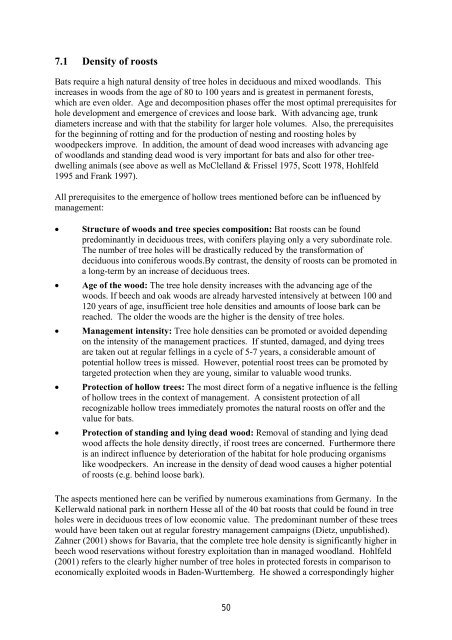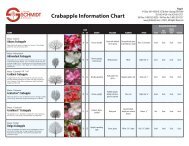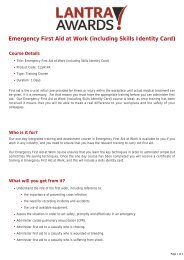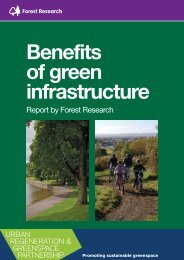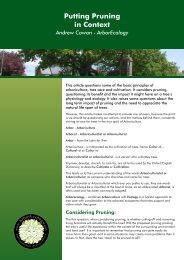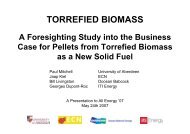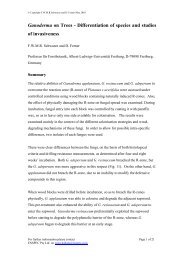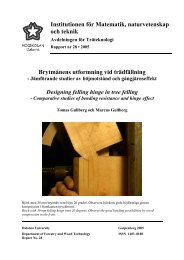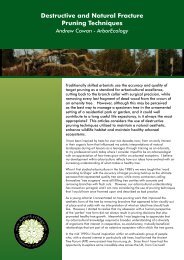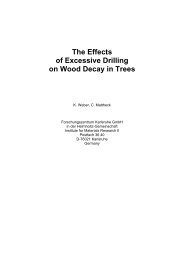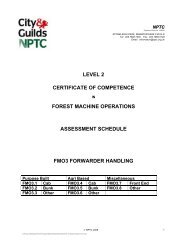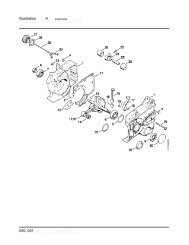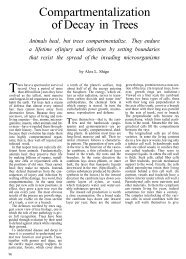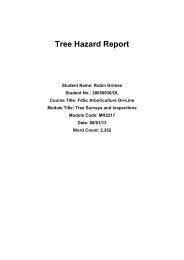working today for nature tomorrow - Justus-Liebig-Universität GieÃen
working today for nature tomorrow - Justus-Liebig-Universität GieÃen
working today for nature tomorrow - Justus-Liebig-Universität GieÃen
- No tags were found...
You also want an ePaper? Increase the reach of your titles
YUMPU automatically turns print PDFs into web optimized ePapers that Google loves.
7.1 Density of roostsBats require a high natural density of tree holes in deciduous and mixed woodlands. Thisincreases in woods from the age of 80 to 100 years and is greatest in permanent <strong>for</strong>ests,which are even older. Age and decomposition phases offer the most optimal prerequisites <strong>for</strong>hole development and emergence of crevices and loose bark. With advancing age, trunkdiameters increase and with that the stability <strong>for</strong> larger hole volumes. Also, the prerequisites<strong>for</strong> the beginning of rotting and <strong>for</strong> the production of nesting and roosting holes bywoodpeckers improve. In addition, the amount of dead wood increases with advancing ageof woodlands and standing dead wood is very important <strong>for</strong> bats and also <strong>for</strong> other treedwellinganimals (see above as well as McClelland & Frissel 1975, Scott 1978, Hohlfeld1995 and Frank 1997).All prerequisites to the emergence of hollow trees mentioned be<strong>for</strong>e can be influenced bymanagement:• Structure of woods and tree species composition: Bat roosts can be foundpredominantly in deciduous trees, with conifers playing only a very subordinate role.The number of tree holes will be drastically reduced by the trans<strong>for</strong>mation ofdeciduous into coniferous woods.By contrast, the density of roosts can be promoted ina long-term by an increase of deciduous trees.• Age of the wood: The tree hole density increases with the advancing age of thewoods. If beech and oak woods are already harvested intensively at between 100 and120 years of age, insufficient tree hole densities and amounts of loose bark can bereached. The older the woods are the higher is the density of tree holes.• Management intensity: Tree hole densities can be promoted or avoided dependingon the intensity of the management practices. If stunted, damaged, and dying treesare taken out at regular fellings in a cycle of 5-7 years, a considerable amount ofpotential hollow trees is missed. However, potential roost trees can be promoted bytargeted protection when they are young, similar to valuable wood trunks.• Protection of hollow trees: The most direct <strong>for</strong>m of a negative influence is the fellingof hollow trees in the context of management. A consistent protection of allrecognizable hollow trees immediately promotes the natural roosts on offer and thevalue <strong>for</strong> bats.• Protection of standing and lying dead wood: Removal of standing and lying deadwood affects the hole density directly, if roost trees are concerned. Furthermore thereis an indirect influence by deterioration of the habitat <strong>for</strong> hole producing organismslike woodpeckers. An increase in the density of dead wood causes a higher potentialof roosts (e.g. behind loose bark).The aspects mentioned here can be verified by numerous examinations from Germany. In theKellerwald national park in northern Hesse all of the 40 bat roosts that could be found in treeholes were in deciduous trees of low economic value. The predominant number of these treeswould have been taken out at regular <strong>for</strong>estry management campaigns (Dietz, unpublished).Zahner (2001) shows <strong>for</strong> Bavaria, that the complete tree hole density is significantly higher inbeech wood reservations without <strong>for</strong>estry exploitation than in managed woodland. Hohlfeld(2001) refers to the clearly higher number of tree holes in protected <strong>for</strong>ests in comparison toeconomically exploited woods in Baden-Wurttemberg. He showed a correspondingly higher50


